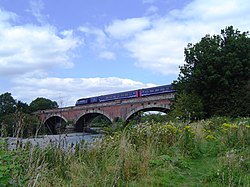Moulsford Railway Bridge | |
|---|---|
 Moulsford Railway Bridge (original) from downstream | |
| Coordinates | 51°33′29″N 1°08′33″W / 51.55806°N 1.14250°W |
| Carries | Great Western Main Line |
| Crosses | River Thames |
| Locale | Moulsford |
| Maintained by | Network Rail |
| Heritage status | Grade II* listed |
| Characteristics | |
| Design | Skew arch |
| Material | Brick |
| Height | 21 feet 8 inches (6.60 m)[1] |
| No. of spans | 4 |
| Piers in water | 3 |
| Rail characteristics | |
| No. of tracks | 4 |
| Track gauge | 1,435 mm (4 ft 8+1⁄2 in) |
| Electrified | 25 kV 50 Hz AC OHLE |
| History | |
| Designer | Isambard Kingdom Brunel |
| Opened | 1839 and 1892 |
| Location | |
 | |
Moulsford Railway Bridge, also known locally as "Four Arches" bridge,[2] is a pair of parallel bridges located a little to the north of Moulsford and South Stoke in Oxfordshire, UK. It carries the Great Western Main Line from Paddington, London to Wales and the West across the River Thames. The bridge lies between the stations at Goring & Streatley and Cholsey, and crosses the Thames at an oblique angle on the reach between Cleeve Lock and Benson Lock.
The original Moulsford Railway Bridge was built between 1838 and 1840, having been designed by Isambard Kingdom Brunel for the main trunk route of the Great Western Railway. Built to carry a pair of broad gauge tracks across the Thames, it consists of four low semi-elliptical arches spanning the Thames at a considerably skewed angle of 60 degrees. During the 1890s, a second bridge was built immediately parallel to the original structure, enabling the railway to be expanded to a quadruple track configuration. The bridge was subsequently recognised as a Grade II* listed structure.[3] During the 2010s, the lines across the structure were electrified
- ^ "Bridge heights on the River Thames". River Thames Alliance. January 2008. Archived from the original on 24 January 2008.
- ^ "The Cholsey Parish Plan" (PDF). Cholsey Parish Council. 2006. Retrieved 28 December 2009.[permanent dead link]
- ^ Historic England. "Moulsford Viaduct (MLN14730) (1285970)". National Heritage List for England. Retrieved 9 April 2016.